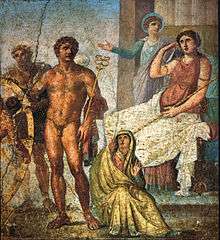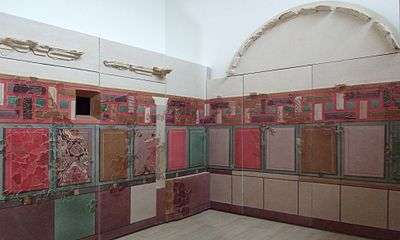Roman wall painting (200 BC–AD 79)

Roman wall paintings are unique pieces of art that have been found in private homes in many different Roman cities, along with the countryside in Italy.[1] The paintings were used to brighten a room since most of the houses were naturally very dark.[2] There are four main styles of Roman wall painting that have been found: Incrustation, architectural, ornamental, and intricate.[3] Each style is unique, but each style following the first, contains aspects of each style previous to it. Any original paintings were created before the eruption of Mount Vesuvius. The first two styles (incrustation and architectural) were a part of the Republican period (related to Hellenistic Greek wall painting) and the last two styles (ornamental and intricate) were a part of the Imperial period.[4]
History
In the first century BC, Roman walls were decorated with different paintings. These paintings ranged from being realistic to impressionist works of art.[5] Inspiration came from mythology, landscapes, and other interests. Typically, paintings were created on plaster that had pigments added to them while they were drying, also known as frescoes.[6] Frescoes were made of one to three coats of mortar along with one to three coats of lime mixed with marble.[7] Many of the paintings that have been discovered today have been found around the Bay of Naples, the area in which Mount Vesuvius had erupted.[8] The paintings have contained depictions of life in this area prior to the great eruption that destroyed much of the countryside and the cities of Pompeii and Herculaneum.[9]
Wall paintings were not only used for decorations, but also for other important functions around the house, such as a guide for guests and a social orientation for the public.[10] The areas in which the paintings decorated the walls were meant for guests to follow and the walls that contained little to no paintings were meant for the servants to use to get around the house.[11] The type of paintings and resources used to complete the paintings indicated the social status of the household.[12]
First Style: Incrustation

From 200 to 60 BC, the style of incrustation was used in Roman wall paintings.[13] This style consists of the wall containing colorful patches of blocks that resembled marble walls.[14][15] The marble-like look was acquired by the use of stucco moldings, which caused portions of the wall to appear raised.[16] The more wealthy romans painted their walls using a variety of colors, but those who were not as wealthy mainly used variations of the colors yellow, purple, and pink.[17] This style was very colorful and simple, but it was also seen as claustrophobic to some people.[18] A couple examples of this style can be found in Pompeii at the House of Faun and the House of Sallust.[19]
Second Style: Architectural

This style was first seen from about 80 BC to the end of the first century BC.[20] The second style incorporated aspects from the first style, such as the marble blocks.[21] The blocks were typically lined along the base of the wall and the actual picture was created on flat plaster.[22][23] However, many paintings from this style involved illusions of imaginary scenes.[24][25] Painters wanted to give off the illusion that the viewer was looking through a window at the scenery depicted.[26] They also added objects that are commonly seen in real life such as vases and shelves along with items that appeared to be sticking out of the wall.[27][28] This style was intended for viewers to feel as though the actions in the painting were taking place around them.
Third Style: Ornamental
Dating from 20 BC to 20 AD, the third style based their painting on the second style, architectural.[29] However, painters that used the ornamental style made use of the flat surfaces of the wall.[30] The walls could be divided into different sections or frames, with each section painted a different color. In this particular style, more wall space is left plainly colored, with no design. When designs were present, they tended to be small, plain pictures or scenes such as a candelabra or fluted appendages.[31] Black, red, and yellow continued to be used throughout this period, but the use of green and blue became more prominent than in previous styles.[32] Most of these paintings had very little extra designs added to them, so many critics claimed that they had no meaning and were therefore worthless.[33] Painters that used this technique found it easy to change the paintings due to the lack of design. Also, only a portion of the wall could be changed instead of re-painting the entire wall.[34] The House of Lucretius contains examples of the third style of wall painting.
Fourth Style: Intricate
This style was prominent from 20 AD to 79 AD, the year that Mount Vesuvius erupted. It is best known as a combination of the three previous styles using the blocks from the first style, architectural scenes from the second style, and large patches of color from the third style.[35] Instead of directly using the aspects from the previous styles, the intricate style added a new spin to each of the styles that were used. Intricate paintings appeared busier and used the wall in its entirety to be complete.[36] Large central panels were used to display a certain picture.[37][38] A combination of themes were painted in these pictures, including mythology, landscapes, and other images.[39] The House of Vetti contains examples of the fourth style and can still be found in Pompeii today.
Post-eruption Painting
All four styles of wall painting were developed prior to the eruption of Mount Vesuvius in 79 AD. Although many examples of Roman wall painting were able to be preserved from the eruption, no new styles of wall painting developed after the incident. People continue to decorate their homes with these paintings, but there were never any new styles that developed, instead, a combination of the four styles was used among painters.[40] Improvements were made to the techniques such as a sheet of lead being added to the base of the wall in order to prevent moisture from destroying the art and using a marble powder to produce a shinier surface.[41] The pieces that are still around today allow people across the world to view a piece of the past.
References
- ↑ http://www.metmuseum.org/toah/hd/ropt/hd_ropt.htm
- ↑ http://depts.washington.edu/hrome/Authors/ninamil7/TheFourStylesofRomanWallPaintings/pub_zbarticle_view_printable.html
- ↑ http://depts.washington.edu/hrome/Authors/ninamil7/TheFourStylesofRomanWallPaintings/pub_zbarticle_view_printable.html
- ↑ http://www.accla.org/actaaccla/ramage.html
- ↑ http://www.ancient.eu/article/597/
- ↑ http://www.metmuseum.org/toah/hd/ropt/hd_ropt.htm
- ↑ http://www.accla.org/actaaccla/ramage.html
- ↑ http://www.metmuseum.org/toah/hd/ropt/hd_ropt.htm
- ↑ http://www.metmuseum.org/toah/hd/ropt/hd_ropt.htm
- ↑ http://depts.washington.edu/hrome/Authors/ninamil7/TheFourStylesofRomanWallPaintings/pub_zbarticle_view_printable.html
- ↑ http://depts.washington.edu/hrome/Authors/ninamil7/TheFourStylesofRomanWallPaintings/pub_zbarticle_view_printable.html
- ↑ http://depts.washington.edu/hrome/Authors/ninamil7/TheFourStylesofRomanWallPaintings/pub_zbarticle_view_printable.html
- ↑ http://smarthistory.khanacademy.org/roman-wall-painting
- ↑ http://smarthistory.khanacademy.org/roman-wall-painting
- ↑ http://depts.washington.edu/hrome/Authors/ninamil7/TheFourStylesofRomanWallPaintings/pub_zbarticle_view_printable.html
- ↑ http://smarthistory.khanacademy.org/roman-wall-painting
- ↑ http://smarthistory.khanacademy.org/roman-wall-painting
- ↑ http://depts.washington.edu/hrome/Authors/ninamil7/TheFourStylesofRomanWallPaintings/pub_zbarticle_view_printable.html
- ↑ http://smarthistory.khanacademy.org/roman-wall-painting
- ↑ http://smarthistory.khanacademy.org/roman-wall-painting
- ↑ http://smarthistory.khanacademy.org/roman-wall-painting
- ↑ http://smarthistory.khanacademy.org/roman-wall-painting
- ↑ http://www.metmuseum.org/toah/hd/ropt/hd_ropt.htm
- ↑ http://smarthistory.khanacademy.org/roman-wall-painting
- ↑ http://depts.washington.edu/hrome/Authors/ninamil7/TheFourStylesofRomanWallPaintings/pub_zbarticle_view_printable.html
- ↑ http://smarthistory.khanacademy.org/roman-wall-painting
- ↑ http://www.metmuseum.org/toah/hd/ropt/hd_ropt.htm
- ↑ http://depts.washington.edu/hrome/Authors/ninamil7/TheFourStylesofRomanWallPaintings/pub_zbarticle_view_printable.html
- ↑ http://depts.washington.edu/hrome/Authors/ninamil7/TheFourStylesofRomanWallPaintings/pub_zbarticle_view_printable.html
- ↑ http://smarthistory.khanacademy.org/roman-wall-painting
- ↑ http://smarthistory.khanacademy.org/roman-wall-painting
- ↑ http://www.ancient.eu/article/597/
- ↑ http://smarthistory.khanacademy.org/roman-wall-painting
- ↑ http://depts.washington.edu/hrome/Authors/ninamil7/TheFourStylesofRomanWallPaintings/pub_zbarticle_view_printable.html
- ↑ http://smarthistory.khanacademy.org/roman-wall-painting
- ↑ http://depts.washington.edu/hrome/Authors/ninamil7/TheFourStylesofRomanWallPaintings/pub_zbarticle_view_printable.html
- ↑ http://smarthistory.khanacademy.org/roman-wall-painting
- ↑ http://www.ancient.eu/article/597/
- ↑ http://smarthistory.khanacademy.org/roman-wall-painting
- ↑ http://smarthistory.khanacademy.org/roman-wall-painting
- ↑ http://www.metmuseum.org/toah/hd/ropt/hd_ropt.htm
- ↑ Ambler, Jessica. "Roman wall painting styles." - Smarthistory. http://smarthistory.khanacademy.org/roman-wall-painting styles.html (accessed October 5, 2014).
- ↑ Cartwright , Mark. "Roman Wall Painting." Ancient History Encyclopedia. http://www.ancient.eu/article/597/ (accessed October 5, 2014).
- ↑ "Heilbrunn Timeline of Art History." Roman Painting. http://www.metmuseum.org/toah/hd/ropt/hd_ropt.htm (accessed October 5, 2014).
- ↑ Kelly, Ramage. "ACTA ACCLA." - Roman Wall Painting. http://www.accla.org/actaaccla/ramage.html (accessed October 5, 2014).
- ↑ "View Article: The Four Styles of Roman Wall Paintings." View Article: The Four Styles of Roman Wall Paintings. http://depts.washington.edu/hrome/Authors/ninamil7/TheFourStylesofRomanWallPaintings/pub_zbarticle_view_printable.html (accessed October 5, 2014).